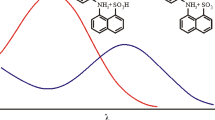Methods of electronic spectroscopy and quantum chemistry are used to compare protolytic vanillin and isovanillin species. Three protolytic species: anion, cation, and neutral are distinguished in the ground state of the examined molecules. Vanillin and isovanillin in the ground state in water possess identical spectral characteristics: line positions and intensities in the absorption spectra coincide. Minima of the electrostatic potential demonstrate that the deepest isomer minimum is observed on the carbonyl oxygen atom. However, investigations of the fluorescence spectra show that the radiative properties of isomers differ. An analysis of results of quantum-chemical calculations demonstrate that the long-wavelength ππ* transition in the vanillin absorption spectra is formed due to electron charge transfer from the phenol part of the molecule to oxygen atoms of the methoxy and carbonyl groups, and in the isovanillin absorption spectra, it is formed only on the oxygen atom of the methoxy group. The presence of hydroxyl and carbonyl groups in the structure of the examined molecules leads to the fact that isovanillin in the ground S0 state, the same as vanillin, possesses acidic properties, whereas in the excited S1 state, they possess basic properties. A comparison of the рKа values of aqueous solutions demonstrates that vanillin possesses stronger acidic and basic properties in comparison with isovanillin.
Similar content being viewed by others
References
N. Yu. Vasil’eva, O. V. Vusovich, N. M. Kozhevnikova, et al., Opt. Atm. Okeana, 15, No. 3, 258–262 (2002).
K. N. Waliszewski, V. T. Pardio, and S. L. Ovando, Food Chem., 101, 1059–1062 (2006).
M. Timotheou-Potamia and A. C. Calokerinos, Talanta, 71, 208–212 (2007).
A. Scharrer and A. Mosandi, Deutsche Lebensmittel – Rundschau, 97, 449–456 (2001)
K. G. Bogolitsyn, V. V. Lunin, D. S. Kosyakov, et al., Physical Chemistry of Lignin [in Russian], Akademkniga, Moscow (2010).
C. A. Von Parker, Photoluminescence of Solutions [Russian translation], Mir, Moscow (1972).
G. V. Mayer, V. Ya. Artyukhov, O. K. Bazyl, et al., Electronically Excited States and Photochemistry of Organic Compounds [in Russian], Nauka, Novosibirsk (1997)
M. E. Solov’ev and M. M. Solov’ev, Computational Chemistry [in Russian], SOLON-Press, Moscow (2005).
V. Ya. Artyukhov and A. I. Galeeva, Sov. Phys. J., 29, No. 11, 949–952 (1986)
Author information
Authors and Affiliations
Corresponding author
Additional information
Translated from Izvestiya Vysshikh Uchebnykh Zavedenii, Fizika, No. 1, pp. 79–86, January, 2014.
Rights and permissions
About this article
Cite this article
Vusovich, O.V., Tchaikovskaya, O.N., Sokolova, I.V. et al. Experimental and Quantum-Chemical Study of Electronically Excited States of Protolytic Isovanillin Species. Russ Phys J 57, 86–94 (2014). https://doi.org/10.1007/s11182-014-0211-0
Received:
Published:
Issue Date:
DOI: https://doi.org/10.1007/s11182-014-0211-0



